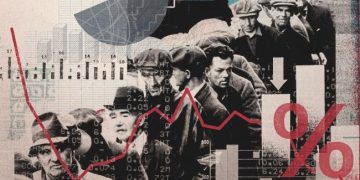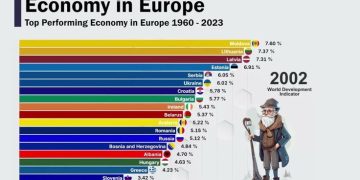This week, the eyes of global investors will be focused on the European Central Bank’s rate-setting meeting. The European Central Bank is widely expected to take the lead in cutting interest rates by major central banks in Europe and the United States. In addition, the central banks of Canada and Russia will also hold interest rate meetings this week. After the Japanese Ministry of Finance confirmed the intervention in the foreign exchange market, how it will affect the trend of the yen is also worth paying attention to.
These financial events are worth watching this week.
This week, the eyes of global investors will be on the European Central Bank’s rate-setting meeting. The European Central Bank is widely expected to take the lead in cutting interest rates by major central banks in Europe and the United States. In addition, the central banks of Canada and Russia will also hold interest rate meetings this week. After the Japanese Ministry of Finance confirmed the intervention in the foreign exchange market, how it will affect the trend of the yen is also worth paying attention to.
ECB cuts interest rates with high probability
On Thursday, the European Central Bank will meet to set interest rates. Judging from the recent statements of a number of European Central Bank officials and market expectations, the European Central Bank is highly likely to cut interest rates. Since September 20, 2023, the European Central Bank raised the benchmark interest rate to 4.5%, it has remained unchanged.

The market’s current focus has shifted to the ECB’s next rate cuts and how often. The consensus now expects at most one more rate cut this year, rather than the six predicted at the start of the year. Prior to the monetary policy meeting held by the European Central Bank on April 11, it decided to continue to maintain the main refinancing interest rate, marginal lending interest rate and deposit mechanism interest rate at 4.50%, 4.75% and 4.00%, and at the same time issued a signal to loosen monetary policy: “If factors such as inflation developments, the outlook and the strength of the transmission of monetary policy strengthen confidence in achieving the medium-term inflation target, it is appropriate to lower the current level of interest rates.”
Francois Villeroy de Gayot, governor of the Bank of France, France’s central bank, said: “Barring a surprise, the first rate cut in June is a given.” But then the ECB has wide discretion to cut rates.”
ECB chief economist Philippe Laing also said that cutting rates too late could allow inflation to fall below the target range, at which point the ECB would be forced to “corrective” rate cuts.
In Europe’s non-euro zone, central banks have cut rates this year in countries including Switzerland, Sweden, the Czech Republic and Hungary. If the ECB chooses to cut rates in June, it will become the first major central bank in Europe and the United States to do so.
Earlier, analysts warned that if the European Central Bank cut interest rates more often than the Fed, it could cause the euro to weaken and import prices to rise, pushing up inflation. Lane noted that the ECB considers “significant” exchange rate movements, but at the moment there is no significant change in the euro’s exchange rate against the dollar. Instead, expectations that the Fed will delay rate cuts have pushed up US bond yields, which in turn have pushed up long-term European bond yields. This means that any interest rate set by the ECB will be “subject to additional tightening” due to the US, and the ECB may need to cut its short-term deposit rate further to offset the US effect.
The yen is in focus
On Friday, Japan’s finance ministry confirmed intervention in the yen at the end of April.
From April 26 to May 29, the Japanese government spent a record 9.8 trillion yen ($62.2 billion) to prop up the yen, according to data released by Japan’s Ministry of Finance. This figure not only exceeds the previous estimate of 9.4 trillion yen, but also exceeds the 9.2 trillion yen spent on all interventions for the whole of 2022.
Despite the unprecedented scale of the Japanese government’s intervention, the market reaction was relatively muted. Despite the large amount of intervention, the market reaction was relatively limited, said Hirofumi Suzuki, chief currency strategist at Sumitomo Mitsui Banking Corp.
Analysts from leading institutions generally believe that the yen is expected to remain under pressure given the large gap between Japanese and US interest rates. Unless there is a clearer indication of when US interest rates will start to fall, or the Bank of Japan becomes more aggressive in raising borrowing costs or cutting back on bond purchases, there is little chance of the yen reversing course.
Masafumi Yamamoto, chief currency strategist at Mizuho Securities, said Japan had had limited success in stemming the yen’s sharp moves and that it was likely to act again. “Japan must have the support of the G7, including the US, before it can intervene again.” “If the yen moves significantly in a single day, say to 158 yen or below from current levels, Japan could act again,” Mr. Yamamoto said.
Canada is under pressure to cut interest rates

Economic data from Canada showed weaker-than-expected growth in the first quarter, adding to speculation that the Bank of Canada may cut interest rates.
Statistics Canada released a report on May 31 local time, showing that Canada’s real gross domestic product grew by 0.4% in the first quarter of 2024, an annualized increase of 1.7%, the growth rate is lower than previously expected. The data points to a slowdown in economic growth, which could prompt the Bank of Canada to adopt a more accommodative monetary policy at its June meeting. The chance of a rate cut by the Bank of Canada on June 5 rose to 80 percent from 66 percent before the GDP data, according to data from the interest rate swap market.
But analysts differ on the exact timing and extent of the cuts.
Douglas Porter, chief economist at BMO Capital, said: “The door is open for the Bank of Canada to cut rates, and we have been leaning towards a June cut. But it will still be a difficult decision, and when the central bank does finally move, the pace will be gradual, with a highly patient Federal Reserve acting as a limit to how far and how fast Canadian interest rates can fall.”
Katherine Judge, senior economist at CIBC Capital Markets, said the latest data showed the economy was “losing steam as the quarter went on,” adding to signs that the Bank of Canada will cut interest rates in its June 5 decision. “Given cooling inflation and weakening momentum in GDP growth, the Bank of Canada remains on track to cut interest rates in June,” she said in a statement.
But Olivia Cross, North America economist at Capital Economics Ltd., doesn’t think the economic data are strong enough to warrant a June cut, so she expects rates to come down in July. James Orlando, senior economist at TD Bank, also expects (the Bank of Canada) to keep rates on hold and use the meeting to prepare for a rate cut in July.
































